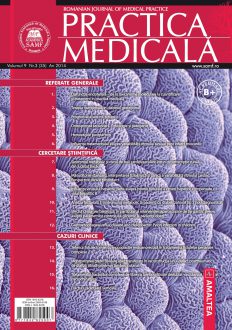SELECT ISSUE

Indexed

| |

|
|
|
| |
|
|
|

|
|
|
|
|
|
|
HIGHLIGHTS
National Awards “Science and Research”
NEW! RJMP has announced the annually National Award for "Science and Research" for the best scientific articles published throughout the year in the official journal.
Read the Recommendations for the Conduct, Reporting, Editing, and Publication of Scholarly work in Medical Journals.
The published medical research literature is a global public good. Medical journal editors have a social responsibility to promote global health by publishing, whenever possible, research that furthers health worldwide.
Gastroesophageal reflux disease and Helicobacter Pylori infection in children
Madalina Adriana BORDEA, Alexandru PIRVAN, Gabriel SAMASCA, Daniel LEUCUTA, Dan GHEBAN and Nicolae MIU
ABSTRACT
Objective. The main aim of our prospective study was to establish the relationship between Helicobacter pylori (H.pylori) infection and Gastroesophageal reflux disease (GERD) in children population. GERD is a multifactorial disorder characterized by reflux of gastric acid into the esophagus, leading to symptoms, mucosal inflammation and injury. There is a strong and probably causal interrelation between bacterial infection, longstanding GERD/peptic esophagitis and esophageal adenocarcinoma in the future, as a consequence. Given a relatively high prevalence of GERD/peptic esophagitis and bacterial infection in the community and their consequences (peptic esophagitis, Barrett ’s esophagus and adenocarcinoma), any relationship between these two conditions is likely to be important for all physicians. The relationship between GERD and H.pylori infection is controversial. There are limited published data in children population. The results of previous studies are contradictory and confusions. Adult studies suggested that bacterial infection may protect against GERD by causing atrophic gastritis, which leads to reduced gastric acid secretion. Contrasting views have been reported in small prospective studies on children population.
Methods. 97 patients with H.pylori infection had esophagogastroduodenoscopy (EGD) with biopsies between 2009 and 2012. Infection with H.pylori was diagnosed by positive culture or from a biopsy sample taken during the endoscopy. Peptic esophagitis was confirmed by endoscopy (macroscopic) as an erosive lesion of the esophageal mucosa (graded by Savary Miller classification). Four weeks after the treatment of bacterial infection (triple therapy), a second EGD with biopsies was performed and the new endoscopic features were noticed.
Results. At the first endoscopic examination, esophagitis was presented in 82 of 97 children enrolled in our study. Post treatment, 52 patients with peptic esophagitis had successfully eradicated H.pylori and 12 of those with normal esophagus at the first endoscopy. The eradication rate of H.pylori was higher in patients with normal esophagus (80%) than in those with esophagitis (63%): 12 of 15 versus 52 of 82 (P < 0.02). Persistent esophagitis in 24 (29%) children who had esophagitis at the first examination was only related to the initially presence of this condition, before eradication. None one case of peptic esophagitis was recorded after H.pylori eradication in our patients with a normal esophagus at the first endoscopy (P < 0.01) and no GERD’s complications (esophageal stenosis, Barrett ’s esophagus or gastric metaplasia) were observed during the study period in the group of patients with peptic esophagitis.
Conclusion. The findings suggest that treatment of H.pylori infection should be considered in children with concomitant GERD. In light of these results, H.pylori eradication therapy is unlikely to either induce or exacerbate peptic esophagitis.
Keywords: relationship, H.pylori infection, GERD/peptic esophagitis, eradication, bacterial infection
